French mortars of the First World War: 220, 270 and 280 mm
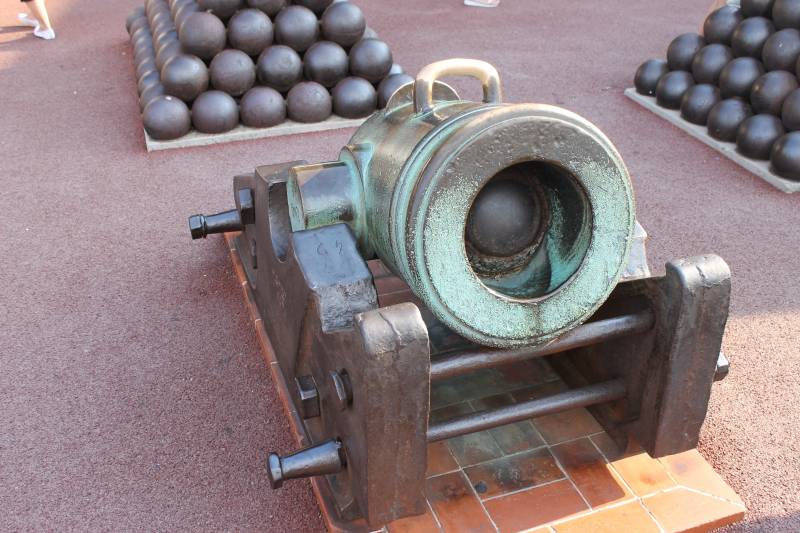
Mortar on the machine along with the core inside in front of the Prince's Palace of Monaco, 2019. Photo by the author
Hit the fountain of fire
And Bob Kennedy started dancing.
What do I care about you all,
And you to me!
Song by Ben Ansley from the movie "The Last Inch". Music: M. Weinberg, lyrics: M. Sobol
Heavy artillery of the First World War. Military operations on the territory of Ukraine today are carried out by artillery systems of 152/155 mm, 203 mm and 240 mm caliber. Larger - only missiles. But during the First World War, the artillery fleet of the warring powers was more than diverse. Moreover, both in caliber and in type. For example, today a mortar can only be seen in a museum or exhibited in a crowded place as an element of the urban landscape. But then there were a lot of them. And today we will tell you about mortars. And so far only about French.
And it will be necessary to start with the fact that in the same artillery park of the French army after the war of 1870-1871 with Prussia, the projects of Charles de Bange began to dominate. In addition to the numerous calibers of field guns, de Bange also developed two heavy howitzers (and in fact mortars) with a caliber of 220 mm and 270 mm.
The first weapon, the siege mortar of 1880 (officially Mortier de 220 mm de siege Modele 1880), was developed by de Bange in the late 1870s and put into service in 1880, and then it was the largest projectile in terms of weight among the guns of de Banja. It was created for firing at long-term defensive structures made of bricks (which were the fortresses of the third quarter of the 19th century) and was able to break through a meter-long brick vault under a meter-long earthen backfill.
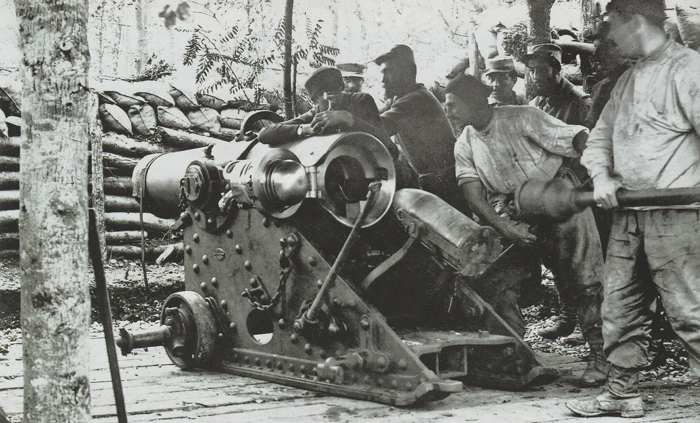
This is how it was loaded: Mortier de 220 mm de siege Modele 1880
The 220-mm barrel was originally mounted on a simple metal platform, but in 1891 it was already placed on a real carriage with a hydraulic recoil brake, similar in design to the Mortier de 270. During the First World War, the difficulty of transporting mortars was overcome due to the fact that the carriage was designed in such a way that it became possible to tow it with heavy trucks. During operation, the Mortier de 220 proved to be a reliable and durable artillery system. So, by the end of the war, 220-mm mortars fired more than 7000 shots per barrel without any failures or destruction of the barrels. In total, about 330 such mortars were produced.
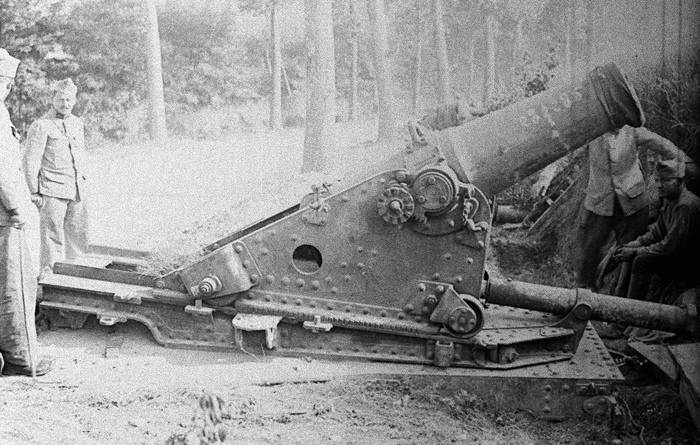
220 mm mortar issued in 1881
As with many large caliber siege artillery pieces of the day, an integral part of mortar deployment was the construction of a wooden base. Usually it took about 5 hours, after which a gun was installed on it. Among the shortcomings of the mortar was the difficulty of loading. The barrel had to be brought to a position close to horizontal so that the projectile could hit the breech, after which the barrel had to be moved back to the firing position, that is, aim again - and so every time after the next shot. Throwing charges (as many as 17 charges) were in caps. The shutter was piston and had the famous obturator de Bange. Typically, the calculation of the gun from 8 people, and its rate of fire was 1 shot every 3 minutes.
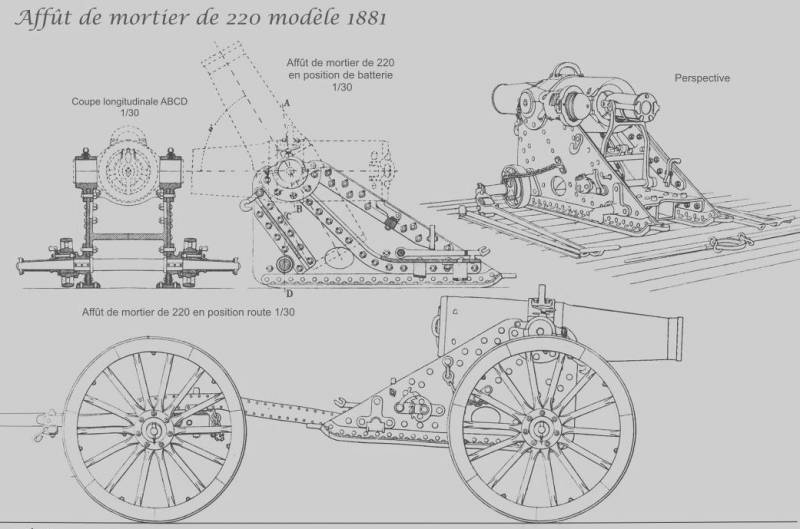
Scheme of the carriage device and its transportation ...
Mle 1880 was transported by a team of 10 horses, that is, it was a whole convoy. But the installation on the position did not take much time and required only 25 minutes, but only on the condition that the wooden platform for the gun carriage was already ready.
Initially, the 220-mm mortar was used in fortresses in open firing positions, where the battery was placed without any protection from above or individually in again open barbets. However, as artillery developed, it became apparent that mortars placed in this way were too vulnerable. Therefore, in 1906, all 220-mm mortars were removed from the fortresses and transferred to the armament of foot artillery.
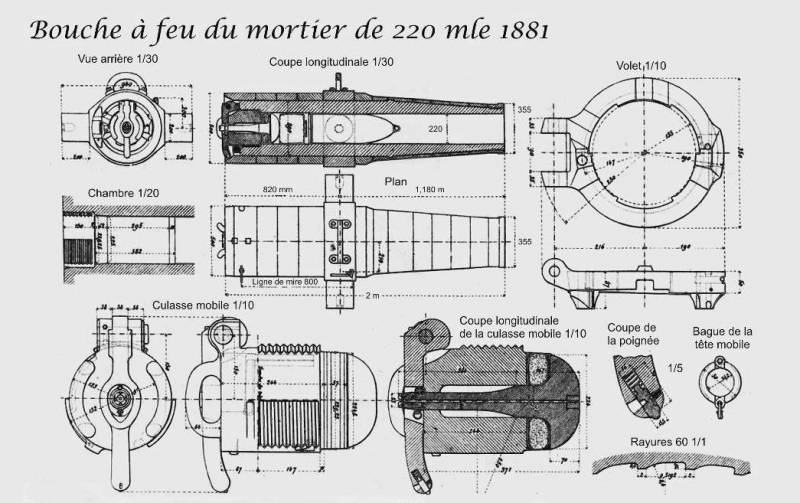
The device of the barrel and piston valve with the "fungus" de Bange
In 1914, only 14 of these mortars were in service, and all the rest were in reserve and in storage. They were supposed to be used in large quantities when attacking the fortified German border town of Metz. However, this did not happen. Nevertheless, the Mle 1880, like the later Mle 1891 mortars, became useful weapons trench warfare. Slow loading was not considered a disadvantage, since they fired 100 kg rounds at decent distances. The peak of their use came in August 1916, when 306 Mle 1880 and Mle 1891 mortars were deployed at the front. The surviving 220-mm mortars were stored after the war, but by 1940 they were all decommissioned.
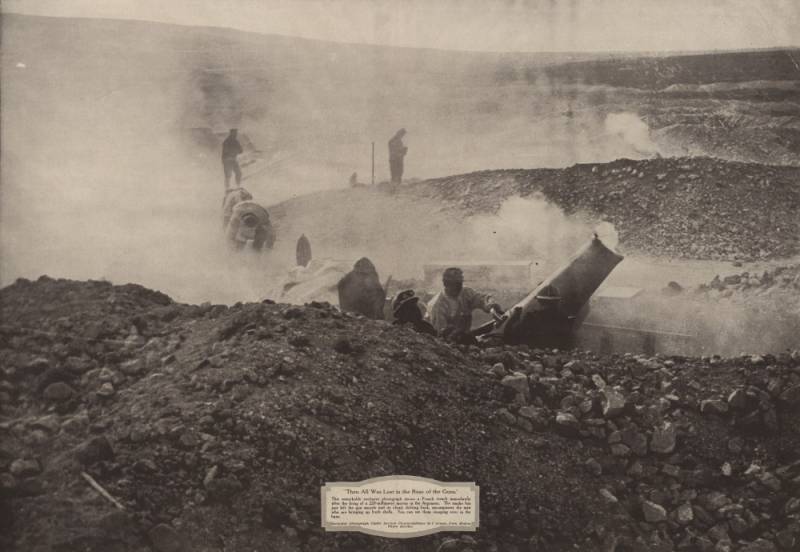
220mm mortars in combat. Western Front, 1915
The weight of a high-explosive projectile of a 220-mm de Bange mortar was at different times from 102 (1880) to 98 (1909) and 100 kg in 1915, with an explosive charge from 9,8 to 28 kg. The mass of the gun installed in position was 4080 kg. Elevation angles from -5° to +60°. Horizontal - only by turning the entire gun.
The rate of fire was noticeably improved, with a continuous rate of fire of 1 shot in 2 minutes being achieved. It is claimed that a rate of fire of 1 shot per minute was possible. The time required to deploy the Mortier has been reduced from 3 to 4 hours instead of 5 hours for the Mle 1880. Interestingly, the 1891 model is now heavier at 8500 kg compared to the 4080 kg for the Mle 1880, although the higher mass may have been added mortar stability and somewhat improved accuracy.
Mle 1891 Mortiers were in service for most of the war. Although the surviving guns were kept after the armistice, they were still disposed of by 1940. An attempt to create self-propelled guns based on the 1891 model failed.
The development of the 270 mm howitzer, despite the fact that a similar 220 mm howitzer was adopted by the French army in 1880, was associated with the desire to have a gun capable of firing projectiles 50% heavier than the 220 mm. It was assumed that a 200-kilogram projectile would be able to destroy any modern fortification.
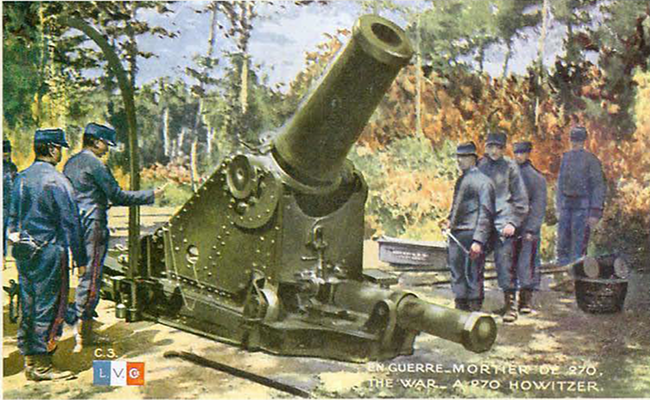
Mortier de 270
The carriage of the new gun was very different in design from many heavy guns of the time, which had to rest on wooden platforms. The Mortier de 270 mm had a base plate that was sunk into the ground and leveled with a level. The all-steel barrel, a novelty of the time, had two large trunnions, and the rise of the barrel could be fixed with screws. Compared to the 220 mm mortar, the barrel was reinforced with hoops both in front of and behind the trunnion block, as well as at the end of the barrel.
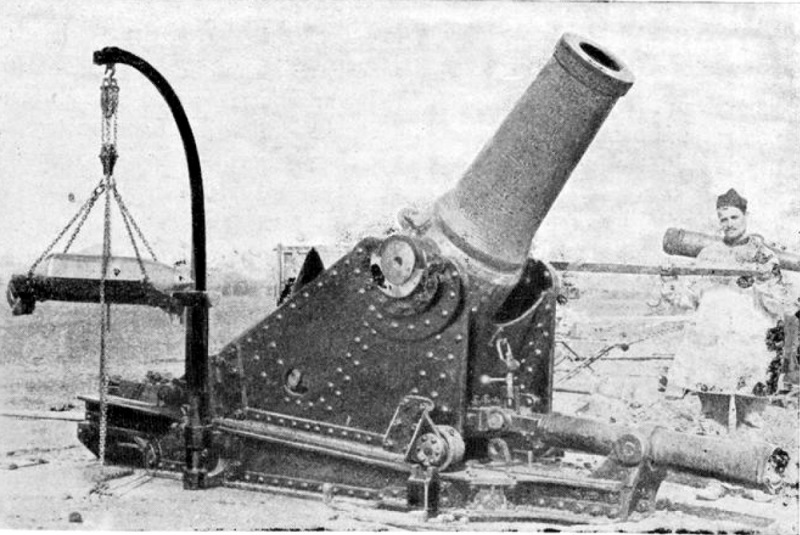
The same mortar with a crane boom and a tray with a projectile
However, the new mortar turned out to be too heavy to be transported as a whole by horse transport, so for transportation it had to be disassembled into 4 parts. By the time of the First World War, it was being towed more and more often by four-wheel drive trucks. Due to the long time required to deploy and move a mortar, it was usually placed in forests, where it was easier to find cover from enemy observers. In addition, the relatively short firing range meant that it had to be deployed very close to the front line, thereby increasing the likelihood of being detected and destroyed by counter-battery fire.
The projectiles for this gun weighed over 150 kg and were lifted to the loading tray by a pulley and pallet hoists, which were attached to the curved boom on the right side of the gun carriage. The loading was capped, ignition using a friction tube, a piston shutter with a de Bange obturator.
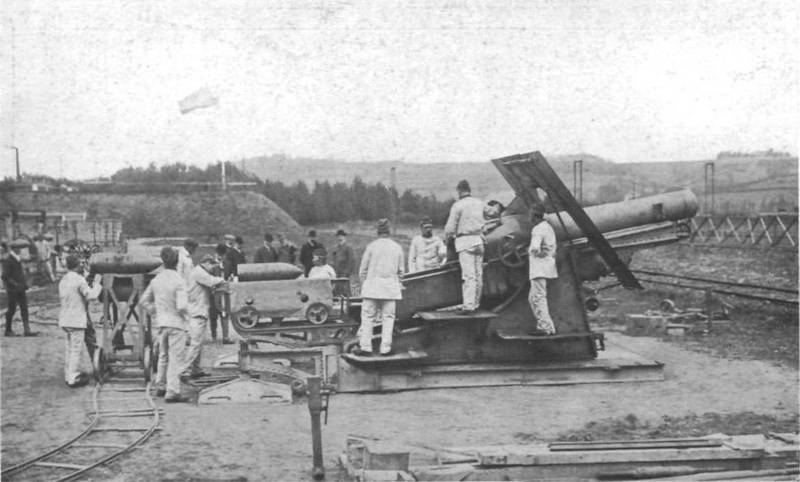
280mm Schneider mortar. At first, the shells were brought to her on one cart, then they were transferred to another. Here was the maeta!
At the start of the First World War, 32 Mortier de 270s were deployed to the front. From November 1915 to April 1916, about 24 mortars were transferred to mobile units moving on trucks as a mobile reserve of heavy artillery in three-gun batteries. But because of their short range, nothing came of this idea. These guns were widely used during the battle of Verdun. It was decided that the 270mm mortar would be replaced by the 280mm Schneider howitzer with an even heavier projectile. But the latter were delivered to the troops very slowly. As a result, 14 Mortier de 270 guns were able to survive until the Compiègne truce. At the same time, they shot more than 3000 shells per barrel. After the war, the surviving guns were sent to storage, so that after the fall of France in 1940, the Germans found 24 such guns in warehouses. However, they never began to use them, but most likely they sent them to be melted down.
The shells of the Mortier de 270 were indeed heavier than those of the 220. So, the high-explosive projectile of the 1899 model had a weight of 232,9 kg, while the charge accounted for 66 kg. The firing range of such a projectile, however, was small. Only 4300 m. But a lightweight 152-kilogram projectile flew already at 8000 m. Vertical guidance angles: from + 0 ° to + 70 °. Horizontal: 30°. Calculation: 8 people. Rate of fire: 1 shot every 2 minutes.
As in the case of 155-mm guns, private arms firms in France were primarily engaged in the production of guns for foreigners, rather than for their own army, which essentially ignored the experience of such an important event as the Russo-Japanese War of 1904-1905. Moreover, the Japanese, who used Krupp's 28-cm licensed howitzers near Port Arthur, turned out to be more far-sighted. Naturally, the lesson learned made the Russian military pay attention to heavy artillery. In 1909, they approached the Schneider firm with a request to develop a new 11-inch (279,4 mm) siege howitzer with a range of 6000 m for the Russian army as part of the ongoing modernization of their artillery.
"Schneider" handed over the prototype to the Russian army for testing already in 1912. The new howitzer was tested against fortifications built specifically for this purpose, and although it was found that its shells could not penetrate modern reinforced concrete fortifications, the main characteristics of the gun were found to be generally satisfactory. 16 howitzers were ordered for delivery in 1915. The French Army also showed interest in this howitzer and decided to replace their 270 de Bange 1885mm howitzers with new 280mm ones. However, the French army hesitated until 1913 before ordering 18 howitzers, apparently noticing that the political situation in Europe was clearly deteriorating day by day and that war was very likely.
Initially, it was assumed that the French guns would have a caliber of 280 mm, but, after thinking, they decided to abandon such a short-sighted "diversity", so that all the howitzers fired were of the Russian caliber of 279,4 mm. The first howitzers were delivered at the end of 1915.
The barrel length of the new gun was L / 12, which gave a maximum muzzle velocity of 418 m / s and, accordingly, provided a firing range of 10 m. The gun had a hydropneumatic recoil damping system, similar to many other French guns. However, under the shield on which it was located, it was necessary to dig a hole into which the barrel was supposed to roll back.
The howitzer was transported in four packs: a barrel, a recoil brake and a knurler assembly, a carriage and a base plate.
The howitzer was designed to be transported by 60 cm gauge railroad. The shells were transported on carts from the warehouse to the rear of the howitzer, where they were loaded onto a loading cart using a crane. It should be noted that the engineers of the French army learned how to lay rail tracks 60 cm wide very quickly.
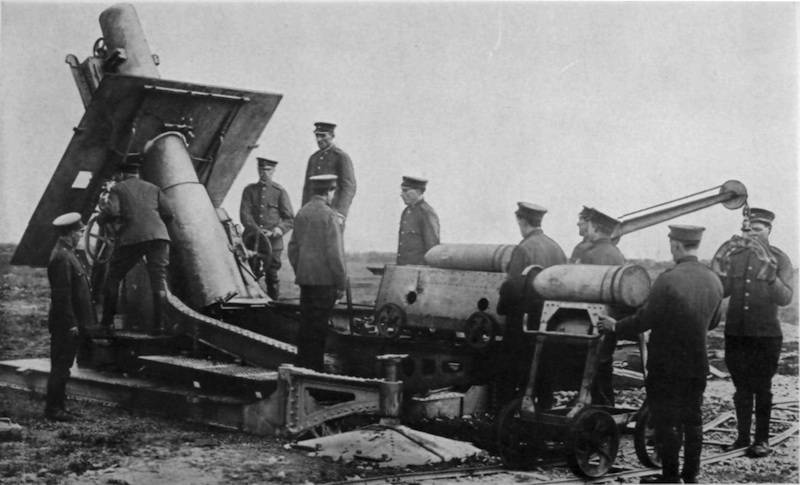
280mm mortar loaded and aiming at target
Under ideal conditions, the howitzer could be assembled in 6-8 hours, although in hard-to-reach places this operation could take up to 18 hours. The debut of the new howitzer took place in April 1916 near Verdun, where it was used to conduct counter-battery fire and attack the fortifications held by the Germans. The counterattack on Fort Douaumont in May 1916 showed that 280 mm shells could not penetrate the vaults of modern fortifications, although in fairness it should be noted that even the German 42 cm shells of the Fat Bertha could not penetrate the vaults of Fort Douaumont.
Gun weight (mounted in position): 16 kg. Elevation angles: +218° to +10°. Horizontal - 65 °. The howitzer could fire 19 different types of projectiles: sample 3 - 1914 kg (205 kg of explosive); 63,6 - 1915 kg (275 kg), and also 51,5 - 1915 kg (205 kg). There were 36,3 variable charges, giving initial velocities from 13 to 178 m/s. By the end of the war, 418 howitzers were delivered to the French army, and before the 126 revolution, 1917 were sent to Russia. In addition, 26 more were installed on the chassis tanks "Saint-Chamond" and turned into self-propelled guns 280 TR Schneider sur affuût-chenilles St Chamond.
In general, the gunners liked these guns, except perhaps for the fact that they did not penetrate strong reinforced concrete floors.
The German army in 1940 captured about 72 of these howitzers and gave them the name 28 cm Morser 601 (f). The Red Army captured and used howitzers of the old Russian order, and in June 1941 there were 25 of them. Bundesarchiv data suggests that they were used on the Eastern Front even in 1944.
To be continued ...
Information